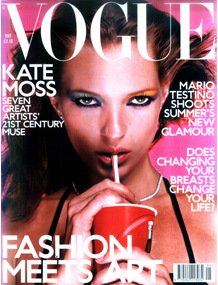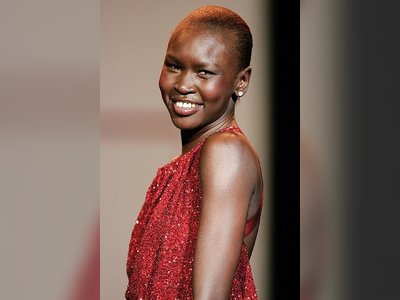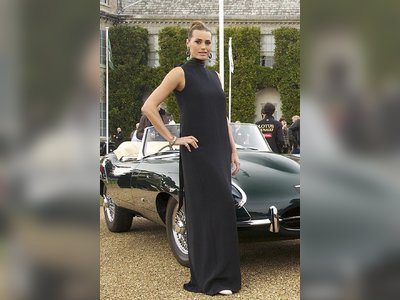British Heritage
Remember, Cherish, Learn.
beta
Kate Moss - The "Anti-supermodel"
Contribution to British Heritage.
Kate Moss, born on January 16, 1974, is a prominent British supermodel and businesswoman who has left an indelible mark on the fashion industry. Emerging in the early 1990s, Moss became an iconic figure in the "heroin chic" fashion trend, breaking away from the traditional supermodel mold and introducing a new aesthetic to the industry. Her influence on British heritage lies not only in her significant contributions to fashion and style but also in her impact on popular culture and the modeling industry itself.
Moss's arrival at the end of the supermodel era signaled a shift in fashion ideals, paving the way for a new wave of models who defied conventional beauty standards. Her collaborations with fashion heavyweight Calvin Klein propelled her to fashion icon status, and her waifish figure and role in popularizing the size zero fashion trend have had a lasting impact on the industry.
Despite facing challenges and controversies, including a drug use scandal in 2005, Kate Moss demonstrated resilience and professionalism, making a successful comeback and continuing to be a sought-after model. Her diverse career has extended beyond the runway, as she has delved into clothing design, musical projects, and even ventured into the world of fashion editorial, contributing to British Vogue.
Moss's immense influence and longevity in the fashion world earned her accolades, including the prestigious 2013 British Fashion Awards recognition for her exceptional contribution to the industry over 25 years. Her recognition as one of Time magazine's 100 most influential people in 2007 solidified her status as a cultural icon and representative of British heritage on a global scale.
Kate Moss's legacy as an "anti-supermodel" goes beyond her striking looks and successful modeling career. She challenged the traditional standards of beauty in the fashion industry and redefined what it means to be a supermodel. While the 1990s were dominated by curvaceous figures like Cindy Crawford and Naomi Campbell, Moss stood out with her waifish frame, sparking a new trend and inspiring a generation of models with more diverse body types to enter the fashion world.
The concept of "heroin chic" that emerged during Moss's early career was controversial but undeniably influential. Her unique look, captured in the black-and-white photographs of Corinne Day for The Face magazine, showcased a raw and unvarnished beauty, creating a stark contrast to the glamorous and polished image of traditional supermodels. This aesthetic has since permeated fashion and photography, leaving a lasting impact on visual culture.
Moss's ability to bounce back from personal challenges and controversies has also solidified her reputation as a resilient and enduring figure in the industry. Her determination to continue her career after being dropped from fashion campaigns due to drug allegations demonstrated her professionalism and dedication to her craft.
Kate Moss's contributions to British heritage are multifaceted, touching upon various aspects of culture and society. As a style icon, she has played a significant role in shaping British fashion trends and influencing global fashion houses. Her collaborations with renowned fashion brands like Chanel, Burberry, and Louis Vuitton have showcased her versatility and enduring appeal in the fashion world.
Beyond her modeling career, Moss has ventured into entrepreneurship, adding to her impact on British heritage. Her clothing range and fragrance lines, including collaborations with Topshop and Coty, have connected her with a wider audience, making her style accessible to fashion enthusiasts worldwide.
Moreover, Kate Moss's philanthropic endeavors have contributed to social causes and helped elevate her status as a cultural figure. Her support for charities such as War Child, Cancer Research UK, and the Elton John AIDS Foundation demonstrates her commitment to giving back to society and using her influence for a positive impact.
In the realm of arts and culture, Moss has been an inspiration to artists and photographers alike. Portraits of her by renowned artists, including Lucian Freud and Chuck Close, have become part of artistic representations of British culture. Notably, the £1.5 million 18-carat gold statue of Moss, crafted by Marc Quinn for a British Museum exhibition, immortalized her as a symbol of contemporary beauty and artistry.
Kate Moss's success in the fashion industry can be measured by her widespread recognition and continued demand as a model. Over the years, she has graced the covers of numerous international Vogue editions, Harper's Bazaar, Vanity Fair, and many other prestigious publications. Her work with esteemed photographers like Mario Testino, Mario Sorrenti, and Steven Klein has contributed to her status as one of the most sought-after models in the world.
Moss's collaborations with major fashion brands have not only been commercially successful but have also solidified her position as a trendsetter. Her influence extends beyond the runway, as she has been credited with popularizing various fashion items, from denim cutoff shorts and skinny jeans to Vivienne Westwood Pirate Boots and Alexander McQueen's skull scarf.
As a cultural icon, Moss's image has been featured in music videos and album covers, and she has even made acting cameos. Her ability to transcend the fashion industry and integrate into popular culture is a testament to her widespread appeal and enduring relevance.
Despite facing occasional controversies, Moss's resilience and professionalism have been integral to her continued success. She has not only navigated through challenging times but also managed to rebuild her career after setbacks, demonstrating her tenacity and commitment to her craft.
In conclusion, Kate Moss's status as an "anti-supermodel" has left a profound impact on British heritage. Her role in reshaping beauty standards, her influence on fashion trends, and her contributions to charitable causes have cemented her place as a British cultural icon. Kate Moss's legacy as a style pioneer and trailblazer in the fashion industry will continue to be celebrated and appreciated for generations to come.
Moss's arrival at the end of the supermodel era signaled a shift in fashion ideals, paving the way for a new wave of models who defied conventional beauty standards. Her collaborations with fashion heavyweight Calvin Klein propelled her to fashion icon status, and her waifish figure and role in popularizing the size zero fashion trend have had a lasting impact on the industry.
Despite facing challenges and controversies, including a drug use scandal in 2005, Kate Moss demonstrated resilience and professionalism, making a successful comeback and continuing to be a sought-after model. Her diverse career has extended beyond the runway, as she has delved into clothing design, musical projects, and even ventured into the world of fashion editorial, contributing to British Vogue.
Moss's immense influence and longevity in the fashion world earned her accolades, including the prestigious 2013 British Fashion Awards recognition for her exceptional contribution to the industry over 25 years. Her recognition as one of Time magazine's 100 most influential people in 2007 solidified her status as a cultural icon and representative of British heritage on a global scale.
Legacy
Kate Moss's legacy as an "anti-supermodel" goes beyond her striking looks and successful modeling career. She challenged the traditional standards of beauty in the fashion industry and redefined what it means to be a supermodel. While the 1990s were dominated by curvaceous figures like Cindy Crawford and Naomi Campbell, Moss stood out with her waifish frame, sparking a new trend and inspiring a generation of models with more diverse body types to enter the fashion world.
The concept of "heroin chic" that emerged during Moss's early career was controversial but undeniably influential. Her unique look, captured in the black-and-white photographs of Corinne Day for The Face magazine, showcased a raw and unvarnished beauty, creating a stark contrast to the glamorous and polished image of traditional supermodels. This aesthetic has since permeated fashion and photography, leaving a lasting impact on visual culture.
Moss's ability to bounce back from personal challenges and controversies has also solidified her reputation as a resilient and enduring figure in the industry. Her determination to continue her career after being dropped from fashion campaigns due to drug allegations demonstrated her professionalism and dedication to her craft.
Contributions to British Heritage
Kate Moss's contributions to British heritage are multifaceted, touching upon various aspects of culture and society. As a style icon, she has played a significant role in shaping British fashion trends and influencing global fashion houses. Her collaborations with renowned fashion brands like Chanel, Burberry, and Louis Vuitton have showcased her versatility and enduring appeal in the fashion world.
Beyond her modeling career, Moss has ventured into entrepreneurship, adding to her impact on British heritage. Her clothing range and fragrance lines, including collaborations with Topshop and Coty, have connected her with a wider audience, making her style accessible to fashion enthusiasts worldwide.
Moreover, Kate Moss's philanthropic endeavors have contributed to social causes and helped elevate her status as a cultural figure. Her support for charities such as War Child, Cancer Research UK, and the Elton John AIDS Foundation demonstrates her commitment to giving back to society and using her influence for a positive impact.
In the realm of arts and culture, Moss has been an inspiration to artists and photographers alike. Portraits of her by renowned artists, including Lucian Freud and Chuck Close, have become part of artistic representations of British culture. Notably, the £1.5 million 18-carat gold statue of Moss, crafted by Marc Quinn for a British Museum exhibition, immortalized her as a symbol of contemporary beauty and artistry.
Success and Influence
Kate Moss's success in the fashion industry can be measured by her widespread recognition and continued demand as a model. Over the years, she has graced the covers of numerous international Vogue editions, Harper's Bazaar, Vanity Fair, and many other prestigious publications. Her work with esteemed photographers like Mario Testino, Mario Sorrenti, and Steven Klein has contributed to her status as one of the most sought-after models in the world.
Moss's collaborations with major fashion brands have not only been commercially successful but have also solidified her position as a trendsetter. Her influence extends beyond the runway, as she has been credited with popularizing various fashion items, from denim cutoff shorts and skinny jeans to Vivienne Westwood Pirate Boots and Alexander McQueen's skull scarf.
As a cultural icon, Moss's image has been featured in music videos and album covers, and she has even made acting cameos. Her ability to transcend the fashion industry and integrate into popular culture is a testament to her widespread appeal and enduring relevance.
Despite facing occasional controversies, Moss's resilience and professionalism have been integral to her continued success. She has not only navigated through challenging times but also managed to rebuild her career after setbacks, demonstrating her tenacity and commitment to her craft.
In conclusion, Kate Moss's status as an "anti-supermodel" has left a profound impact on British heritage. Her role in reshaping beauty standards, her influence on fashion trends, and her contributions to charitable causes have cemented her place as a British cultural icon. Kate Moss's legacy as a style pioneer and trailblazer in the fashion industry will continue to be celebrated and appreciated for generations to come.
- Kate Mossen.wikipedia.org








